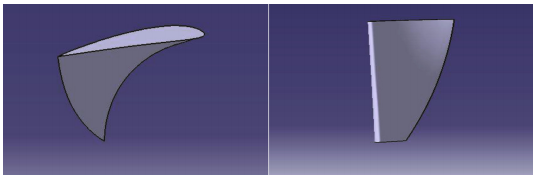
Fig. 1. 3D model of blade designed using CATIA software.
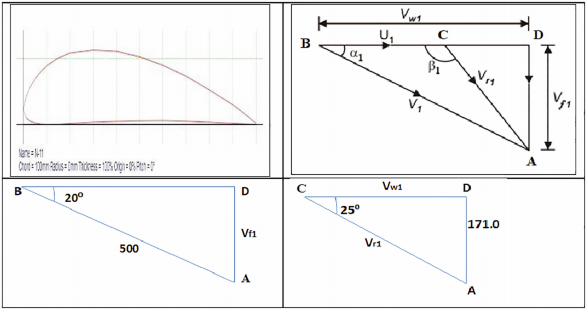
Fig. 2. Velocity Triangles of the blade.



3.2 Structural analysis of blades The gas forces namely tangential, axial were determined by constructing velocity triangles at inlet and exit of the rotor blade. The analysis was carried out by using the blade profile because of its function of conserving the kinetic energy of the flowing steam or gas into the mechanical work on the turbine shell [11]. At first static structural analysis has been done on NACA (N series) blade profile. The input properties for static analysis is shown in Table 6. The Figs.3–10 shows the CFD stages of the blades.
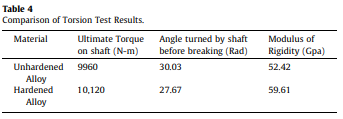
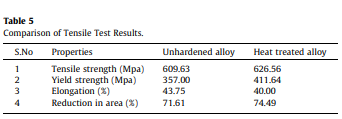
3.3 Modal analysis
The study of the dynamic properties of systems in the frequency domain was carried out by using the modal analysis. The purpose of a modal analysis is to find the shapes and frequencies at which the structure will amplify the effect of a load [12]. Modal analysis provides an overview of the limits of the response of a system.
Every object has an internal frequency (or resonant frequency) at which the object can naturally vibrate [13]. It is also the frequency where the object will allow transfer of energy from one form to the other with minimal loss here vibrational to kinetic. It is important to know these frequencies at which the structure can behave erratically. The independent and normalized displacement pattern was superimposed and amplified to create a resultant displacement pattern [14]. The number of mode shapes created was directly proportional to degrees of freedom of the structure. The frequencies at different modes are given in Table 7.
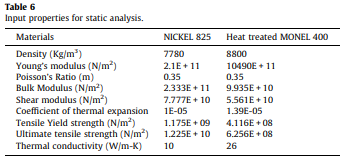
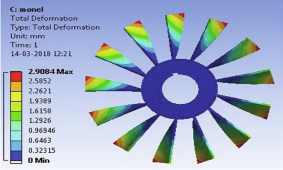
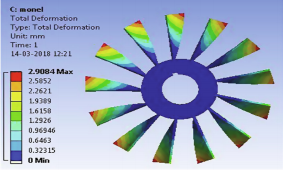
Fig. 3. Nickel (Def. 2.733 mm, Pressure: 1 Mpa) Fig. 4. Heat treated alloy (Def: 2.90 mm,
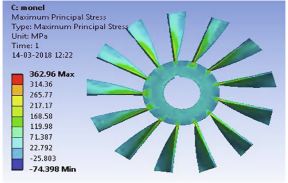
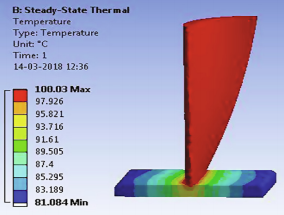
Fig. 6. Heat treated (Max Stress: 362.9Mpa, Fig. 7. Nickel 825 – Temp Distribution.
3.4. CFD analysis
ANSYS CFX is a reliable and accurate high-performance computational fluid dynamics (CFD) software tool that delivers solutions quickly and robustly across a wide range of CFD and multi-physics applications. CFX is recognized for its outstanding accuracy robustness and speed with rotating machinery such as pumps, fans, compressors, and gas and hydraulic turbines. The entire turbine is enclosed by a rectangular surface. The inlet and outlet of fluid flow is mentioned by named selection. The fluid used in this study is air of density 1.225 Kg/m3 and viscosity 1.7845 E-05. The boundary conditions are inlet velocity 2000 m/s and all other faces are constrained. The fluent will calculate based on number of iterations as mentioned. The Fig. 11 shows the fluent analysis of the turbine blade with air flow.
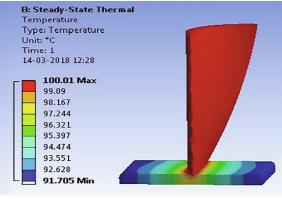
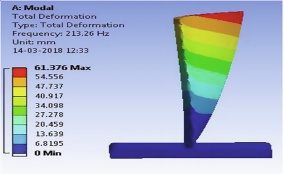
Fig. 8. Heat treated alloy – Temp Distribution. Fig. 9. Nickel 825 (Max: 213.62 Hz).
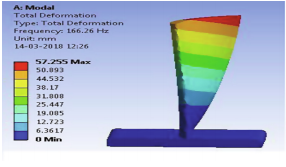
Fig. 10. Heat treated alloy (Max: 166.26 Hz).

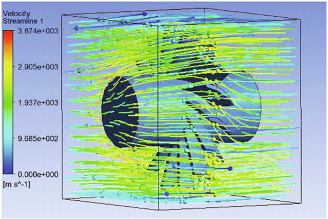
Fig. 11. Fluent Analysis with air Flow.
4. Conclusion
The given Monel 400 metal is heat-treated by quenching process and as per the conducted tests, the metal shows that properties are improved when compared with unhardened alloy and the properties are similar to Nickel 825. Thus, the cost of the turbine blades can be drastically reduced. Since the Monel 400 is cheaper than the latter, the use of it is cost-efficient. Further on analyzing in the ANSYS 16.0 software, the deformation of the blades, stress concentration, temperature distribution in the blades by using the properties of Monel 400 heat-treated alloy is more or less similar to that of Nickel 825 alloy. CFD analysis results also correlates the fact that the impact strength has been decreased significantly and the hardness is drastically increased which resulted in the reduction of wear. The deformation and stress developed in ANSYS is lesser than the safe stress limit of the material. Modal analysis is performed in ANSYS workbench for both the Monel and Nickel, which shows that the resonance frequency for heat treated Monel 400 is lesser than that of Nickel 825. This indicates that the heat treated Monel alloy presented in this study provides promising results that can be used in direct application of turbine blades.

